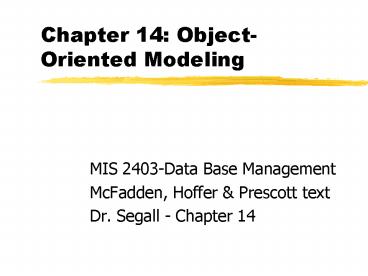Chapter 14: ObjectOriented Modeling - PowerPoint PPT Presentation
1 / 20
Title:
Chapter 14: ObjectOriented Modeling
Description:
Something that is or is capable of being seen, touched, or otherwise sensed. ... Lack of accepted standards (UML) Lack of development tools. Performance ... – PowerPoint PPT presentation
Number of Views:37
Avg rating:3.0/5.0
Title: Chapter 14: ObjectOriented Modeling
1
Chapter 14 Object-Oriented Modeling
- MIS 2403-Data Base Management
- McFadden, Hoffer Prescott text
- Dr. Segall - Chapter 14
2
Object-Oriented Data Modeling
- Merger of two fields
- Data and Process Modeling
- Object-oriented programming languages
- SmallTalk C Visual Basic Micro-Focus COBOL
Visual C
3
Core Concepts
- Objects
- Encapsulation
- Classes
- Inheritance
- Identity
- Domains
4
Object
- Websters Dictionary definition of an object.
- Something that is or is capable of being seen,
touched, or otherwise sensed. - Add to this the concept that we want to store
data and information about the behaviors of the
object, and you have the information systems
concept of objects
5
Examples of Objects
- An employee, customer, vendor, and student are
examples of person objects. - A particular warehouse, regional office,
building, and room are examples of place objects.
- A product, vehicle, equipment, video tape, or a
window appearing on a users display monitor are
examples of thing objects. - An order, payment, invoice, application,
registration, and reservation are examples of
event objects.
6
Object (Text definition, p.171)
- An entity that has a well-defined in the
application domain, and has state, behavior and
identity. Can be an - Tangible or Visible Entity (e.g. Person, Place,
or Thing) - Concept or Event (e.g. Order, Registration)
- Artifact of the design process (e.g. User
Interface, Scheduler)
7
3 Sections of Object
Object Name
Attributes
Methods
8
Customer Order
Object Name
ORDER
Order No. Order Date Promised Date CUSTOMER PRODUC
T Qty. Ordered
Attributes
Methods
Compute_Total
9
Methods
- A processing routine that is encapsulated in an
object and operates on the data described within
that object
Order order number order data order status add
order modify order delete order display
status etc.
Customer
Display order status of order 23161
Message request
10
Encapsulation
- Property that the attributes and methods of an
object are hidden from outside world and do not
have to be known to access its data values or
invoke its methods. - Interface--made known to outside world.
- Order received--methods to fulfill order not
known to outside
11
Classes
- Logical grouping of objects that have same
attributes and behavior (methods) - Pentel Color Pen BIC Stic have similar
attributes they can both belong to WritingPen
class. - Faculty and students also have similar
attributes, and could both belong to the PERSON
class.
12
Inheritance
- When classes are arranged in a hierarchy, each
class assumes the attributes and methods of its
ancestors (supertype). - The class which inherits the attributes and
methods is called a subtype
Person
Which attributes are unique to student
and faculty, and which are generic to person?
What about methods?
Student
Faculty
13
Identity
- External identifier for each object that is not
accessible to and cannot be modified by any other
object or application - Not a data value stored with the object
- Not a primary key as in other database models
14
Domains
- May be of any data type
- standard domains from other data models
- integer, date, character
- abstract data type (defined by user)
- atomic (single) data value or multiple data
values (array) - another object or set of objects
- images, video, audio
15
Limitations of ODBMS
- Lack of accepted standards (UML)
- Lack of development tools
- Performance
- Data Management Facilities
- concurrency control, backup recovery
- Query languages-
- advantage of encapsulation (ability to hide data
structures within objects) causes problems with
queries.
16
Connecting Objects
- A connection is a mapping from one object class
to another - When a connection exists, expect objects to
exchange messages
ORDER
CUSTOMER
PRODUCT
17
Generalization
- Some things are types of other things
- Generalization hierarchy
- hierarchical grouping of objects that share
common attributes and methods - Employee--hourly, salaried, consultant
- Exhaustive--no other subclasses known
- Exclusive--must belong to one and only one
subclass
18
Assembly Structures
- Combining objects to form an assembly (whole)
ORDER
Order No. Order Date Promised Date CUSTOMER PRODUC
T Qty. Ordered
Objects
19
Methods
- Encapsulation of methods (processing routines)
within objects - 3 Types
- Occur--provides basic maintenance
- Occur.Add Occur.Change
- Occur.Delete Occur.Select
- Calculate--math on data values
- Monitor--monitors some system or system
characteristic e.g., InventoryCheck
20
Advantages
- Closer representation of reality
- Greater productivity in developing applications
- Ability to model complex data types like images
and documents































